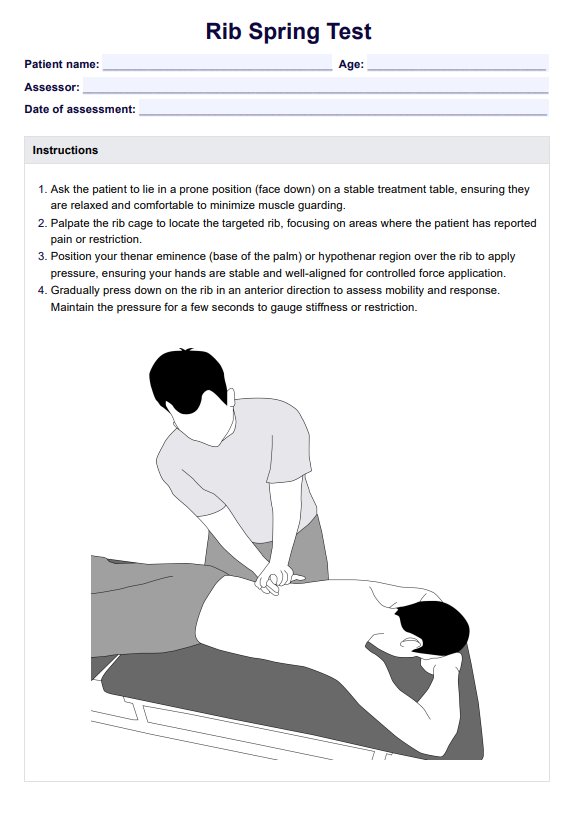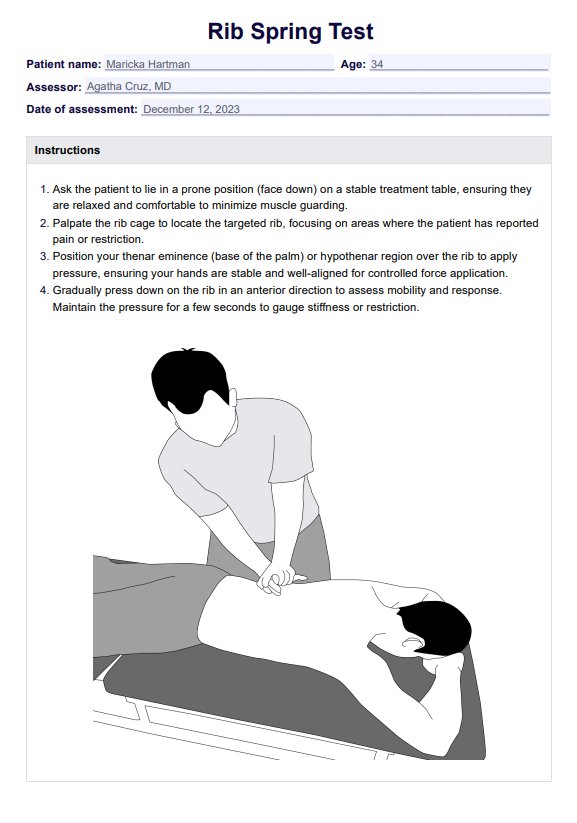Rib Spring Test
Enhance patient care with the Rib Spring Test guide. Learn how to perform this test from our comprehensive template. Download now for free!


What is the Rib Spring Test?
The Rib Spring Test, also known as the rib spring maneuver, is a physical examination technique used by healthcare professionals to assess the rib cage's mobility and function, particularly the costovertebral and costotransverse joints. This test helps identify rib dysfunction, which may contribute to musculoskeletal pain, restricted movement, or impaired thoracic function. It is particularly useful in assessing conditions related to the vertebral column, including cervical rib anomalies and thoracic spine-related pain.
The test is performed with the patient in a prone position, ensuring a stable and relaxed posture for accurate assessment. The clinician applies a downward pressure to the rib, followed by a quick release, allowing the rib to "spring" back. A positive Rib Spring Test is indicated by the reproduction of the patient's pain, suggesting possible rib dysfunction or hypomobility (Scozzafava et al., 2020). Patients with risk factors such as prior chest trauma, poor posture, or repetitive strain may be more prone to restricted rib mobility.
Additionally, the Rib Spring Test can aid in differentiating musculoskeletal-mediated pain from visceral sources of discomfort. It is particularly relevant for patients presenting with chronic thoracic pain, atypical abdominal pain, or movement-induced discomfort, as well as those who experience pain while taking a deep breath.
A positive test may indicate restricted rib motion or dysfunction that could benefit from interventions such as manual therapy, osteopathic manipulation, myofascial release, or targeted exercises. Furthermore, because the cervical region can influence thoracic mechanics, addressing potential dysfunctions in this area may also contribute to improved rib mobility.
Rib Spring Test Template
Rib Spring Test Example
How to use our Rib Spring Test template
Follow these steps to conduct the test effectively and ensure accurate documentation using our template.
Step 1: Download our template
First, download our Rib Spring Test template to record patient information and test results effectively. Click the "Use template" button to access it via the Carepatron app where you can modify it for your needs. For a simple PDF version, click "Download."
Step 2: Explain the test to your patient
Before performing the Rib Spring Test, explain its purpose and procedure to the patient. Inform them that the test assesses rib mobility and potential dysfunction, which may be contributing to their pain or restricted movement. Reassure them that the procedure involves applying gentle pressure to the ribs and is generally well tolerated. Encourage them to communicate any discomfort or pain they experience during the test.
Step 3: Position the patient correctly
Ensure the patient is in the proper position for an accurate assessment. Ask them to lie prone (face down) on a treatment table in a relaxed posture, with their arms comfortably resting at their sides. This position helps minimize muscle guarding and allows for an accurate evaluation of rib mobility. Confirm that the patient feels at ease before proceeding with the test.
Step 4: Perform the Rib Spring Test
Stand beside the patient and place your hand over the rib being tested, typically at the angle of the rib. Apply a gradual, anterior-directed force to assess the rib's mobility and the patient’s response. After applying pressure, quickly release it, allowing the rib to "spring" back into place. Observe whether the patient experiences any discomfort, stiffness, or reproduction of their symptoms, as this will help determine the test outcome.
Step 5: Document your findings in the template
Document whether the test result is positive or negative. Include details on pain reproduction, stiffness, or abnormal rib mobility. Any additional clinical notes or recommendations should also be recorded to support diagnosis and treatment planning.
Step 6: Plan the next steps
Based on the test results, determine the appropriate course of action. A positive Rib Spring Test suggests possible rib dysfunction, costovertebral joint restriction, or musculoskeletal pain, which may require manual therapy, osteopathic manipulation, or further assessment. A negative test result indicates normal rib mobility and may suggest that other factors, such as visceral or neurological issues, should be explored as potential causes of the patient’s discomfort.
Benefits of using our free Rib Spring Test template
Using our Rib Spring Test template provides numerous advantages for healthcare professionals, ensuring efficiency, accuracy, and high-quality patient care. Below are the key benefits of incorporating this structured tool into your assessments.
Consistency in documentation
Our template ensures a standardized approach to recording test results, reducing variability in data collection across different clinicians. This consistency helps establish clear diagnostic patterns, making it easier to track a patient’s progress over time and compare findings across multiple assessments.
Improved efficiency
By following a structured format, you can quickly document findings without missing crucial details. The template streamlines the assessment process, allowing you to focus on patient care rather than paperwork.
Comprehensive and accurate records
Incomplete or inconsistent documentation can lead to missed diagnoses or misinterpretation of findings. Our Rib Spring Test template ensures that all relevant clinical details are captured systematically. This reduces the risk of overlooking critical information that could impact treatment decisions.
Enhanced patient care
Thorough documentation leads to better-informed clinical decisions, which directly improves patient outcomes. By using the template, you can provide a more accurate diagnosis, develop targeted treatment plans, and ensure seamless follow-ups. The structured format also makes it easier to explain findings to patients, promoting transparency and engagement in their own care.
Professional support and clinical reference
For clinicians working in multidisciplinary teams, our Rib Spring Test template serves as a valuable reference tool. Whether used in primary care, physical therapy, or specialized musculoskeletal evaluations, the template helps maintain high standards of care and facilitates collaborative decision-making.
Reference
Scozzafava, A., Newman, D. P., Jacobs, A. N., Sorge, J., & Elster, E. A. (2020). A novel approach to assessing and treating musculoskeletal-mediated atypical abdominal pain: A case study. Cureus. https://doi.org/10.7759/cureus.12359
Commonly asked questions
The rib springing technique is a manual therapy method used to assess and improve rib mobility and thoracic expansion. It involves applying rhythmic pressure to the ribs, often during respiration, to evaluate movement restrictions and enhance rib cage flexibility. This technique is commonly used in respiratory therapy, osteopathic manipulation, and musculoskeletal assessments.
The Rib Spring Test is a clinical assessment where the examiner applies downward pressure to a rib and then quickly releases it, observing its spring-like recoil. A positive test indicates rib dysfunction, such as hypomobility, joint restriction, or pain reproduction, suggesting musculoskeletal involvement. This test helps differentiate rib-related pain from visceral causes and guides appropriate treatment.
A positive Rib Spring Test suggests restricted rib mobility, costovertebral joint dysfunction, or musculoskeletal pain. It is indicated by reproduction of the patient’s pain, limited movement, or excessive stiffness upon rib compression and release. This finding may warrant manual therapy, osteopathic adjustments, or further evaluation for thoracic and rib-related conditions.







































































































